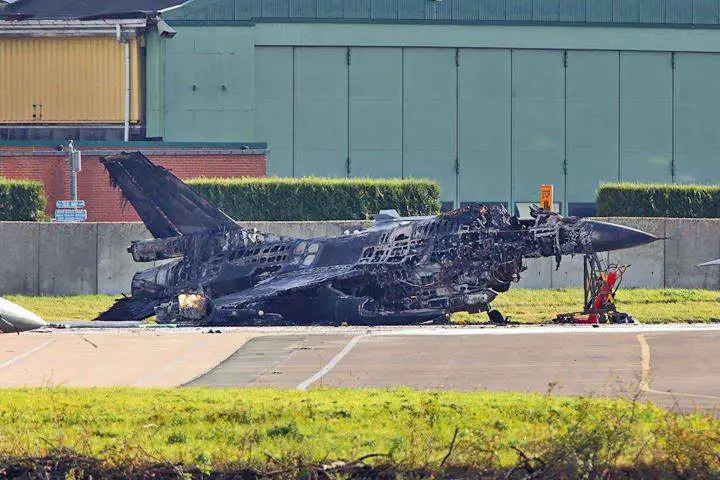Winston
Lorenzo von Matterhorn
- Joined
- Jan 31, 2009
- Messages
- 9,560
- Reaction score
- 1,749
I wonder if US military aircraft T.O.s are translated into other languages. That would be one heck of a task if so.
Belgian F-16 Completely Destroyed By Another F-16 After Mechanic Accidentally Fires Cannon On The Ground
14 Oct 2018
https://theaviationist.com/?p=62176
A Belgian Air Force F-16 has been destroyed and another aircraft damaged when the M61A1 Vulcan 20mm cannon on board a third F-16 was accidentally fired on the ground by maintenance personnel at Florennes Air Base in the Walloon area of Southern Belgium on Friday, Oct. 12, 2018.
Multiple reports indicate that a mechanic servicing the parked aircraft accidentally fired the six-barreled 20mm Vulcan cannon at close range to two other parked F-16s. Photos show one F-16AM completely destroyed on the ground at Florennes. Two maintenance personnel were reported injured and treated at the scene in the bizarre accident.
In a nearby hangar, positioned at the extension of the flight line, a technician was working on an F-16. It is said that by accident the six-barrel 20mm Vulcan M61A-1 cannon of that F-16 was activated. Apparently, the cannon was loaded and some ammunition hit the FA128. This aircraft had just been refuelled and prepared together with another F-16 for an upcoming afternoon sortie. After impact of the 20mm bullets, FA128 exploded instantly and damaged two other F-16s.
The news report published late Friday went on to say, “The F-16 was parked near a hangar when it was accidentally fired upon from another F-16 undergoing routine ground maintenance. Several detonations were heard and thick black smoke was seen for miles around. Civilian firefighters have even been called in to help firefighters at the airbase to contain the incident. About thirty men were deployed on site and several ambulances were dispatched. The Aviation Safety Directorate (ASD) is currently investigating the exact cause.”
The accident is quite weird: it’s not clear why the technician was working on an armed aircraft that close to the flight line. Not even the type of inspection or work has been unveiled. For sure it must have been a check that activated the gun even though the aircraft was on the ground: the use of the onboard weapons (including the gun) is usually blocked by a fail-safe switch when the aircraft has the gear down with the purpose of preventing similar accidents.
Because strict weapons safety protocols, especially with live ammunition, are in place during ground handling it is extremely rare for maintenance personnel to accidentally discharge an aircraft’s weapon.
It is the second time this year an accidental discharge of live aircraft weapons has happened in Europe. On Aug. 7, 2018, a Spanish Air Force Eurofighter Typhoon accidentally launched an AIM-120 Advanced Medium Range Air to Air Missile (AMRAAM) while on an air policing mission near Otepää in Valga County, southern Estonia. The incident occurred only 50km from the Russian border.

Belgian F-16 Completely Destroyed By Another F-16 After Mechanic Accidentally Fires Cannon On The Ground
14 Oct 2018
https://theaviationist.com/?p=62176
A Belgian Air Force F-16 has been destroyed and another aircraft damaged when the M61A1 Vulcan 20mm cannon on board a third F-16 was accidentally fired on the ground by maintenance personnel at Florennes Air Base in the Walloon area of Southern Belgium on Friday, Oct. 12, 2018.
Multiple reports indicate that a mechanic servicing the parked aircraft accidentally fired the six-barreled 20mm Vulcan cannon at close range to two other parked F-16s. Photos show one F-16AM completely destroyed on the ground at Florennes. Two maintenance personnel were reported injured and treated at the scene in the bizarre accident.
In a nearby hangar, positioned at the extension of the flight line, a technician was working on an F-16. It is said that by accident the six-barrel 20mm Vulcan M61A-1 cannon of that F-16 was activated. Apparently, the cannon was loaded and some ammunition hit the FA128. This aircraft had just been refuelled and prepared together with another F-16 for an upcoming afternoon sortie. After impact of the 20mm bullets, FA128 exploded instantly and damaged two other F-16s.
The news report published late Friday went on to say, “The F-16 was parked near a hangar when it was accidentally fired upon from another F-16 undergoing routine ground maintenance. Several detonations were heard and thick black smoke was seen for miles around. Civilian firefighters have even been called in to help firefighters at the airbase to contain the incident. About thirty men were deployed on site and several ambulances were dispatched. The Aviation Safety Directorate (ASD) is currently investigating the exact cause.”
The accident is quite weird: it’s not clear why the technician was working on an armed aircraft that close to the flight line. Not even the type of inspection or work has been unveiled. For sure it must have been a check that activated the gun even though the aircraft was on the ground: the use of the onboard weapons (including the gun) is usually blocked by a fail-safe switch when the aircraft has the gear down with the purpose of preventing similar accidents.
Because strict weapons safety protocols, especially with live ammunition, are in place during ground handling it is extremely rare for maintenance personnel to accidentally discharge an aircraft’s weapon.
It is the second time this year an accidental discharge of live aircraft weapons has happened in Europe. On Aug. 7, 2018, a Spanish Air Force Eurofighter Typhoon accidentally launched an AIM-120 Advanced Medium Range Air to Air Missile (AMRAAM) while on an air policing mission near Otepää in Valga County, southern Estonia. The incident occurred only 50km from the Russian border.




